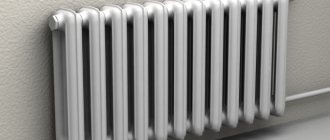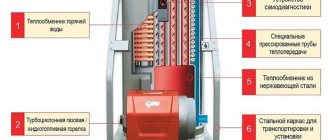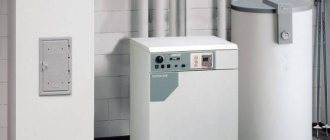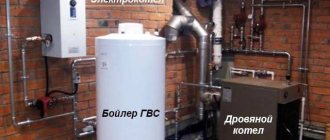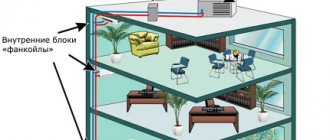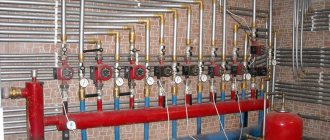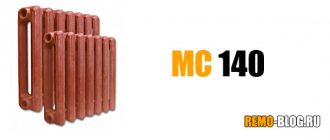Gas heating at home
One of the most inexpensive options is gas heating, but only if gas is supplied to your land. With gas heating there is no dust, dirt or soot. A gas boiler should be selected depending on the heated area. Boilers come in low, medium and high power. Gas boilers are equipped with devices that ensure safe operation. But there is always a danger of explosion if used incorrectly, or gas poisoning.
For residents of Russia, gas is the best option for heating a private home due to the most affordable price. An important factor when installing a gas facility is a large number of permitting documentation.
Heating schemes for a private house
Water heating is considered one of the most effective solutions for a private home. It is a closed circuit with wiring. The coolant, heated by the boiler, constantly moves through the pipeline.
The system can be installed in different ways. For each specific cottage, the best heating scheme is selected at the design stage. To make the right decision, it is important to familiarize yourself with the schemes listed below and evaluate their advantages and disadvantages.
Depending on the type of coolant movement, there are:
- Schemes with natural circulation - movement is carried out due to pressure differences. Hot water is supplied through risers, then enters the mains and radiators. When laying pipes, a slight slope is maintained, about 3-5 °C. The main advantage of this solution is complete energy independence and a minimum of equipment in the system.
- Schemes with forced circulation - the movement of the coolant is carried out by a pump that pumps heated water and sucks in cooled water. The advantage of such a system is the ability to heat rooms of any size, without the need to maintain a slope. The downside is energy dependence.
Depending on the number and features of connecting risers, connection diagrams vary.
Single-pipe - coolant is supplied to all radiators sequentially. The advantages of this option include ease of installation, affordable cost, and low labor costs. The disadvantages are the need to use a pump and the inability to regulate the temperature in individual rooms.
By installing a bypass pipe, shut-off valves on each radiator, as well as other equipment, you can reduce the negative impact of the minuses. However, the cost of installing the system will increase.
Two-pipe vertical - such a scheme allows you to connect a direct and return line to each battery. The boiler can be connected to the top or bottom. Such a solution will significantly increase the cost of the heating system, but will provide the ability to control temperature in each room.
Two-pipe horizontal - the diagram assumes a parallel connection of the supply and return lines located horizontally. This solution is most often used for heating cottages. Hot water is supplied to all radiators almost simultaneously, which makes it easy to ensure a comfortable temperature in all rooms. If the cottage has several floors, a separate circuit is created for each.
Two-pipe horizontal circuits are divided into the following subtypes:
- dead-end - characterized by low costs, ease of installation and calculations, however, in places with low water speed, stagnation zones may appear;
- passing - involves the sequential connection of all radiators around the perimeter of the house, the total length of the supply and return is approximately the same, so all devices operate under equal hydraulic conditions;
- collector is the most complex scheme, but it allows you to save on pipes, ensures uniform heating of the room, and an attractive appearance of the room due to hidden wiring.
When choosing a heating scheme, professionals increasingly recommend two-pipe systems with forced circulation. This ensures uniform heat distribution and reduces the likelihood of individual areas freezing on cold days.
Electric heating
The advantage of an electric boiler is ease of installation and a small number of permitting documents. This boiler practically does not require maintenance. Electric heating is suitable for areas where natural gas is not available.
Electric heating is an environmentally friendly form of energy. It can be carried out using infrared heaters, using electric heated floors, using oil heaters, electric boilers of various designs. To convert electrical energy into heat, electric convectors are usually used for private houses. This is usually a metal case in which a heating element is mounted, which heats the air inside the case.
Warm heated air rising upward heats the room. Convectors are equipped with a temperature sensor. These devices are quite expensive, and the level of electricity consumption is quite high. When heating a large area, it is not advisable to use them. The water heating system using electric heating elements does not differ from systems that use boilers running on other types of fuel.
Electricity will be the best heating for a private home if the house is small, if you have nightly electricity tariffs, if there is no gas and there is no desire to heat it with coal.
Vodyanoye
Water heating is a closed system through which hot water continuously circulates. The boiler acts as a heating element. Radiators are installed in each room. From the boiler, water circulates through pipes along the circuit and, passing through radiators, gives off heat.
The benefits of a water system depend on the type of fuel used by the boilers. If there is a gas main nearby, then it is wiser to purchase a gas boiler. Gas fuel is considered the most economical. However, such structures require regular maintenance by special services. For non-gasified areas, it is better to purchase solid fuel boilers.
It is not advisable to use liquid fuel for the boiler, since it is expensive and will require the construction of a special tank in the ground to store it.
Fuel consumption
Example No. 1. Calculation of fuel consumption in a water heating system: gas will act as fuel, since it is the most common. For the calculation, you will need the power of the unit and the area of the heated housing. The boiler power for a private building is determined based on the proportion: 1 kW per 10 m². For a room of 100 m² you will need a 10 kW boiler.
To calculate fuel consumption, it is necessary to multiply the boiler power by 24 hours and by 30 days. As a result, we get 7200 kW/hour. Since the unit does not always operate at full capacity, this number must be divided by 2. Monthly fuel consumption is approximately 3600 kW/hour. The heating season lasts approximately 7 months. Fuel consumption during the heating period is 3600*7 = 25200 kW/hour. Considering that 1 m³ of fuel produces 10 kW/hour of energy, we get: 25200/10 = 2520 m³.
Let’s convert the resulting value into a monetary equivalent: the national average cost of gas per 1 m³ is 4.97 rubles. Accordingly, gas heating for the year: 4.97 * 2520 = 12524.40 rubles.
Advantages and disadvantages
The main advantages of a water heating system are:
- prompt heating of even a large room;
- quiet operation;
- ensuring the same temperature in all rooms;
- fuel economy;
- ease of maintenance and repair;
- increase in operational life.
Disadvantages include the labor-intensive installation of the installation compared to other systems, the need for constant monitoring of the operation of the boiler, as well as the need to remove water before preserving the system.
Water heating pros and cons
Water heating devices play the role of a closed system or an open one. The closed cycle system does not require the consumption of additional water. This option reduces the amount of energy spent on “heating the street.” Water heating concepts do not trap dust inside or spread dust into the home. Don't forget that heating your home with water heaters is a long process.
Pros and cons of solid fuel heating boilers
Solid fuel boilers use solid fuel: fuel briquettes, pellets, firewood, coal. They have relatively low heat transfer. In order to properly heat a large house, you need to spend a large amount of fuel and your own efforts. In this situation, the fuel will burn quite quickly in two to four hours.
At this point in time, there are long-burning boilers. Fuel can be loaded into them twice a day, or even once every 30 hours. But these boilers also have their drawbacks, for example, low efficiency (70%).
There will also be a need for auxiliary devices - this is the arrangement of additional traction in some cases or a heat accumulator. Don’t forget about the positive components of solid fuel boilers. They work on all types of solid fuel and anything that can burn. It is not difficult to obtain such fuel at a reasonable price. Solid fuel heating is the best in areas where civilization has not reached and gas supply will not be available soon. And if on top of everything you have a big house.
What is the best way to heat?
There are as many opinions about how to heat a house as there are people. Some people prefer to heat with electricity, some with gas, and others with coal. Let's consider each option.
Coal is used in areas where there is no gas pipeline or as a backup type of heating. When burned, coal emits a large amount of smoke and soot. It has low humidity levels. This property ensures the release of high temperature. Due to the use of coal, the room becomes very dirty, and it is also necessary to have a place to store fuel. It is necessary to periodically maintain the combustion process by adding a new batch of coal into the boiler and cleaning the boiler itself.
Electricity is a costly service for heating large areas. It can be used in small rooms and compact spaces. In our regions there are often power outages, and therefore, despite the variety of electric heater installations (from infrared emitters to boilers and electric boilers), there is a risk of being left not just without light for an indefinite period, but also in a cold house.
Gas is the best and most popular heating option for a private home, for all types of areas and houses, since it completely warms up the space.
What is the difference between the top wiring and the bottom
With top wiring, hot liquid is driven upward through the riser. From there it goes down to the batteries. The supply pipe is connected to the battery in its upper part, the outlet pipe in the lower part.
This option is only possible if there is a circulation pump in the circuit. Recommended for buildings with two or more floors.
With the bottom circuit, both pipes are connected to the battery below. The wiring is suitable for one-story cottages.
There are also vertical and horizontal wiring diagrams.
In the first case, hot liquid is supplied to the radiators through risers. This option was previously used in multi-story urban buildings; now such water heating of a private house is sometimes found in two-story cottages.
In a horizontal scheme there is only one riser. Pipes radiate from it across the floors. This option is now more common. It is more rational: in case of an emergency, you can turn off the water only on one floor.
Upper wiring. 1 - boiler, 2 and 3 - hot line, 4 - inlets to batteries, 5 - outlets from batteries, 6 - cold line, 7 - expansion tank
Radiators or water convectors, which is better?
Convectors are based on the principle of heating a room through air flow. It heats up as it passes through the body of the heating installation. In turn, radiators heat the room by radiating heat from the surface body.
Radiators have gained great popularity. Their operating principle can be compared to the operation of a Russian stove.
Convectors are heating panels; they heat a space using the movement of cold and warm air masses. The convector includes a pipe in which the coolant is located. The pipe is framed by ribs, plates that heat the surrounding space. The plates are often made of copper or steel. Convectors are divided into external and built-in. The first type of convectors is mounted on the wall, the second can be mounted along the floor or wall. Convectors also include warm baseboards. This device is an excellent solution for people who do not want to depend on public heating systems.
Convectors are used as additional and main heating; they are especially indispensable in places where standard radiators are not used. For example, built-in convectors in the floor are also located along sliding doors and glass walls. Convectors heat a room much faster and cool it down faster. The devices are durable in use.
If it is better for you when heating a private house when the room warms up faster and more evenly, then install convectors. The most common options are steel radiators (60% convection) or copper-aluminum (90% convection). If these points are not important, then install regular radiators.
Advantages and disadvantages of a water heating system
The main disadvantage of water heating in a private home is the need to purchase a large number of different materials. Namely: pipes, shut-off valves, fittings, radiators, boiler and circulation pump. The latter is not used in all systems.
And other shortcomings that can be described as nonsense if the owner of the house is indifferent to his home:
- Water leaks during operation. Today this situation is rare because plastic pipes have been replaced by plastic pipes. But even they sometimes leak at the junctions with other materials. These are already claims against the installation manufacturer.
- The water inside the system may freeze if it is not drained for the winter. This situation is for houses that are not used during the cold season.
Plastic pipes have solved many problems
Water heating has more advantages, which is why the majority of developers of new houses choose it:
- uniform distribution of heat throughout all rooms;
- installing one heating boiler makes it possible to control the process from one place;
- all equipment, except radiators, and piping can be made hidden. That is, organize a boiler room in the office space, and hide the pipes in grooves on the walls or in the floor. Using a heated floor system generally solves the problem of hidden installation. Even the radiators will not be visible;
- The coolant temperature does not exceed +95°C. And the surface of the batteries heats up to +65°C. You can’t get burned on them; dust doesn’t burn on them;
- water heating produces soft heat.
Heating system with hidden pipe wiring
Water heated floors
Water floors guarantee a comfortable stay in the room. A water heated floor is a rather complicated design, but it is cost-effective due to its convenience and coziness. Installation of such a structure costs a pretty penny, but is popular due to its low operating costs. Pipes are laid under the flooring, and heated water circulates through them. A pump is required for proper circulation. The heating option is very suitable for large country houses that do not have central heating connected. In this situation, purchasing and installing a water floor will be cheaper than purchasing and installing an electric heating system (due to electricity prices).
Selecting a heating system
Which heating is better for the home, which fuel will be cheaper and more efficient? There are general criteria by which you can determine the most optimal option: 1) The right price-quality ratio. In this case, high efficiency is implied: the system must provide the building with the required amount of heat, and the costs for it must be kept to a minimum. 2) Availability of maximum automation. A modern heating system should require minimal intervention during operation. Most owners prefer to set up the system once and not touch it again. High-quality heating systems make this possible. 3) Reliability. The system should be as reliable as possible so that its elements do not have to be updated every six months. 4) Easy to install. Installation of the entire system should be simple and require a minimum of costs. In some cases, installation requires specific tools that may not be useful in the long run. The following types of most common heating systems are distinguished:
Heating boilers
differ in the type of fuel and are divided into three main categories: solid fuel, gas and electric.
When choosing a boiler, you should: understand the advantages and disadvantages of each type, calculate the optimal power and heating area, decide on the appropriate type of fuel for the given area, decide on the number of circuits, choose the location of the intended placement. Gas boilers. It is worth determining its location - whether it will be wall-mounted or floor-mounted. An equally significant factor is its energy dependence; the equipment can be autonomous or must be connected to the mains. These models are single-circuit and double-circuit, the first provide only heating, and the second provide heating and hot water heating. Electric boilers. Such boilers must be selected according to their power (this is a universal parameter for any model), type of connection (220V or 380V), principle of power control (stepped or smooth), as well as heating method (heating element or electrode). Solid fuel boilers. When choosing them, we advise you to pay attention to the fuel used by the boiler (coal, firewood, pellets), the method of loading it (automatic or manual), the heat exchanger material, the volume of the combustion chamber, energy consumption, etc. The boiler is the main element of the water heating system. Water heating
is a closed system within which water heated in the boiler circulates.
The coolant enters the radiators, gradually releases its heat, after which it is again supplied to the boiler by gravity or circulation pumps to heat the liquid. The main elements of water heating
are distinguished 1) gas, electric or solid fuel boiler, which is responsible for heating water and other coolants. Such boilers can operate from various fuels, are equipped with automatic control systems, and are capable of operating in autonomous mode. 2) Radiators in an autonomous heating system can be cast iron, aluminum, steel, or bimetallic. The latter, due to their efficiency, reliability and durability, have gained the greatest popularity.
3) An expansion tank in the system is necessary to level out the thermal expansion of the coolant and ensure the tightness of the entire system. The dimensions and material from which the expansion tank is made are selected individually in each specific case, depending on the branching of the system, the volume and properties of the coolant and a number of other parameters. The closed loop is made of metal or special high-temperature plastic pipes with steel braiding and reinforcement.
Advantages of water heating:
long service life;
fuel economy; the ability to maintain the same temperature throughout the house; almost silent operation; efficient and fast heating of the room. Which
heating radiators
to choose?
First, you need to understand which material will be preferable.
Cast iron radiators are the cheapest. In addition, they last much longer than others and do not rust. Steel panel heating radiators for home fit well into the interior of rooms, perform the heating function well and are slightly more expensive than cast iron ones. Aluminum radiators are among the most popular. Among the advantages of this type are light weight, sufficient strength, and design. Due to the fact that the radiator consists of sections, it is possible to select the optimal number of sections necessary to heat a room of a given size. Such a device can be chosen for installation in an apartment, as well as in a house with an autonomous heating system. Bimetallic radiators are radiators consisting of a steel pipe and coated with aluminum. The combination of the properties of these two metals provides greater resistance to pressure and water quality. Accordingly, this type is also possible to choose for both apartments and houses.
Criterias of choice:
1) Type of heating system.
This factor is paramount when choosing a battery, because different levels of water pressure in two heating systems lead to the need to choose different types of devices.
In Russia there are centralized and autonomous heating systems. The best choice for a central heating system would be cast iron and bimetallic radiators. For an autonomous heating system, experts recommend aluminum and steel radiators. 2) Heat transfer.
Aluminum has the highest heat transfer properties.
This characteristic of steel is also quite high. 3) Reliability and durability.
In terms of durability, cast iron is the strongest.
If a cast iron battery is made of high-quality raw materials and parts, then when buying it, you can count on up to 50 years of uninterrupted operation. In second place are radiators made of steel and bimetallic; they can last up to 25 years. 4) Aesthetic appearance.
Everything is simple here: the design of radiators for the room to combine in harmony with furniture and household items.
5) Installation and connection.
To understand which heating radiator to choose for a house or apartment, you need to know what type of connection is suitable: side or bottom.
How to choose a water heated floor?
When choosing a heating design, the type of installation, room parameters, coating materials, strength of supporting structures and the requirements are taken into account. The classic option is concrete technology, when the water floor is installed in a concrete screed with preliminary installation of insulation and moisture insulation. There are also flooring systems made of wood or polystyrene. According to general requirements, the minimum thickness of the screed is 20 mm, but if reinforcement is not used, the figure increases to 40 mm (with a pipe diameter of up to 25 mm). Above pipes, the thick layer does not exceed 55-65 mm in residential premises, car showrooms, fitness clubs and restaurants - up to 200 mm, for hangars and production workshops the figure rises to 300 mm. When calculating a water floor, the linear parameters of the rooms, the material and thermal insulation of the walls, the type of finished base, the parameters and type of pipelines used, and the temperature of the incoming coolant are taken into account. Using these indicators, the length of the heating circuit, the pitch of the pipes and the layout of the screed are determined.
At ProClimat, highly qualified professionals will help you correctly calculate and select a heating system for your home or apartment!
Which radiator heating is better?
There are many radiator heating systems for private homes. They can be conditionally divided according to the following criteria:
With natural circulation
- Single pipe system
- Spider system
- Leningradka
- Moscow
With forced circulation
- Single-pipe
- Two-pipe (tee)
- Radial
Gravity systems are inferior in all respects to forced ones in heating a house. They should only be considered when there are serious problems with light. In other cases, choose a two-pipe or radiator radiator system. These systems are easy to balance and distribute heat more evenly across heating appliances.
Heating with natural circulation
Example of a single-pipe system with natural circulation
Systems with natural circulation, or gravity flow as they are also called, have been used for quite some time. From the name itself we understand that they work without the help of special devices (pumps), and their work occurs due to natural physical laws.
We all probably remember from school physics lessons that a heated liquid or gas always moves upward. It is precisely this principle that underlies such heating. Heating up in the boiler, the water begins to move up through the pipes. Having reached the furthest heating device, it begins to go down back to the boiler, where it heats up again and circulates upward. When installing a system with self-circulation, a slope must be created in the water return section. And at the coolant supply, at the highest point of the system, it is necessary to install an expansion tank, which will act as a buffer compensating for the increase in liquid volume.
Advantages of gravity heating
As already noted, gravity water heating systems at home have been used for quite a long time and have already proven themselves, as they have certain advantages:
- Cheapness. After all, this system does not require the installation of additional equipment.
- Easy to install and repair (it’s even possible to build a heating system in your own home yourself).
- Work in the absence of electricity. For some time, until the boiler temperature drops below 50 degrees, the liquid will continue to circulate through the system.
- Almost completely silent operation, again due to the absence of a pump.
Disadvantages of gravity heating
But with all the above advantages, heating systems with self-circulation have many disadvantages that make it inappropriate to use this method of heating a house today.
- It is impossible to use this type of system for large rooms. Even for a two-story private house, water circulation will be difficult.
- Temperature difference in heating devices. The farther the room is from the boiler, the colder it will be there. Moreover, the difference can sometimes be significant - up to 5 degrees.
- Heating regulation is difficult. Firstly, the system will start working only when the boiler heats up to 50 degrees; accordingly, you will not be able to make the heating power in the house lower than this mark. Secondly, even when installing heat regulators, the temperature error will be from 3 to 5 degrees, which is quite significant.
Such systems are gradually losing their relevance and are being replaced every year by more modern compulsory systems. We recommend that you use water heating with natural circulation only if you want everything simpler.
